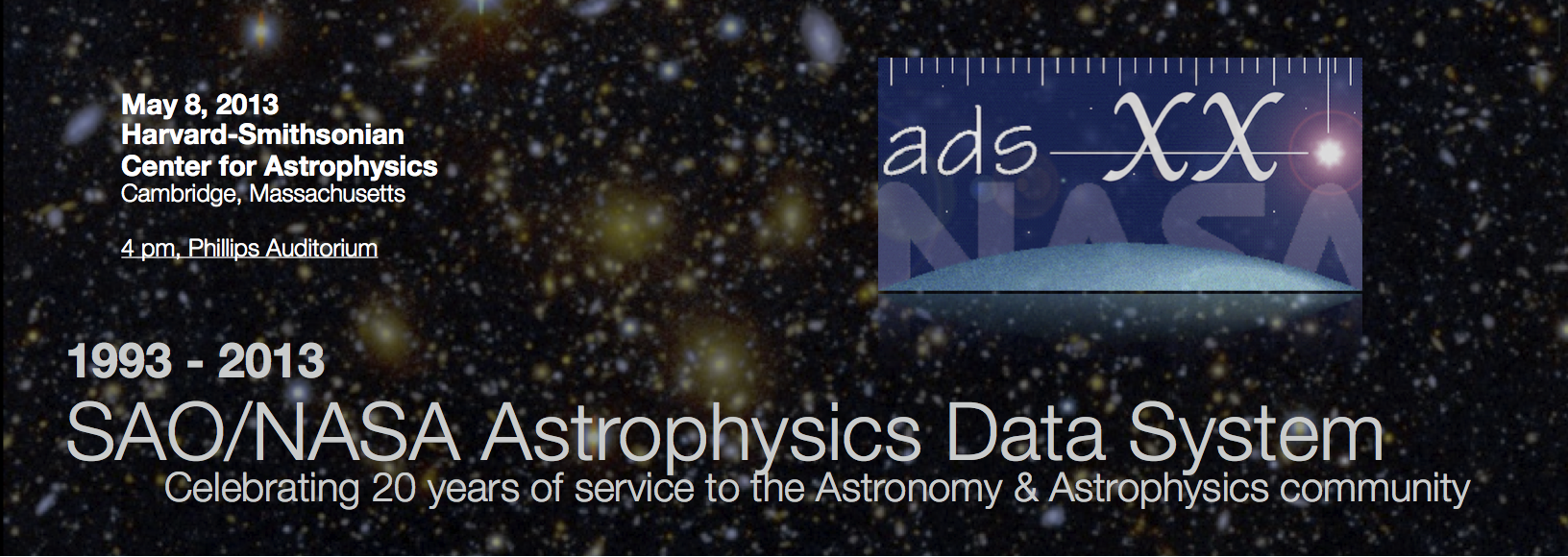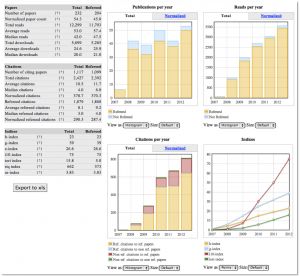In the Spring of 1993, the Smithsonian/NASA Astrophysics Data System (ADS) was first put on-line for general use; its existence was revealed at the ADASS conference that past November (1993ASPC…52..132K). It was known then as the ADS Abstract Service, a component of the larger Astrophysics Data System effort which had developed a sophisticated internet based infrastructure predating the then just released Mosaic web browser by a couple of years. The change to the web occurred the next year.
In 2013, the ADS finds itself as the central discovery engine for astronomical information, used nearly every day by nearly every astronomer. Moving into its third decade, the ADS continues to serve the research community while remaining at the forefront of the massive technological and sociological changes occurring in the field of scholarly communication.
Celebration of May 8, 2013
To celebrate this important event, the Harvard-Smithsonian Center for Astrophysics hosted a colloquium on May 8th 2013 at 4pm EDT. The keynote speaker was Prof. Christine Borgman, the Presidential Chair and Professor of Information Studies at UCLA, who spoke about the role of information systems in scholarly communications.
Here is a recording of the talk, starting with an introduction by the CfA director, Prof. Charles Alcock.
ADS, Astronomy, and Scholarly Infrastructure
Christine L. Borgman
Professor & Presidential Chair in Information Studies, University of California, Los Angeles
And
Oliver Smithies Visiting Fellow and Lecturer, Balliol College, University of Oxford
Astronomy has a history of data collection that spans millennia. While known as a “big data” field, astronomy also has pockets of “long tail science,” characterized by small teams that manage data locally. Astronomy data are diverse in terms of instrumentation, disposition, and use, and yet astronomers often must aggregate and compare datasets with disparate origins. Findings from observational studies and theoretical modeling, in turn, are reported in a wide array of international journals. Celestial objects are the focus of study in these papers, and these objects can be described in many ways. Astronomy is distinctive among the sciences in having built a sophisticated information infrastructure to optimize the access to scientific publications and data. At the core of this infrastructure is the Smithsonian/NASA Astrophysics Data System (ADS), which is celebrating its 20th anniversary. ADS began as a data system, became a bibliographic system, and is now the coordinating mechanism for publishing, data, ontologies, bibliometrics, scientometrics, and other tools and services for using astronomical information. The talk will reflect on the role that ADS has played in scholarly communication in astronomy and in the larger scientific community, and on how it is positioned to lead science in the next 20 years.
Christine L. Borgman is Professor and Presidential Chair in Information Studies at UCLA. Currently (2012-13) she is the Oliver Smithies Visiting Fellow and Lecturer at Balliol College, University of Oxford, where she also is affiliated with the Oxford Internet Institute and the eResearch Centre. Prof. Borgman is the author of more than 200 publications in information studies, computer science, and communication. Her monographs, Scholarship in the Digital Age: Information, Infrastructure, and the Internet (MIT Press, 2007) and From Gutenberg to the Global Information Infrastructure: Access to Information in a Networked World (MIT Press, 2000), each won the Best Information Science Book of the Year award from the American Society for Information Science and Technology. She conducts data practices research with funding from the National Science Foundation, Sloan Foundation, and Microsoft Research. Current collaborations include Monitoring, Modeling, and Memory, The Transformation of Knowledge, Culture, and Practice in Data-Driven Science, and Empowering Long Tail Research.



